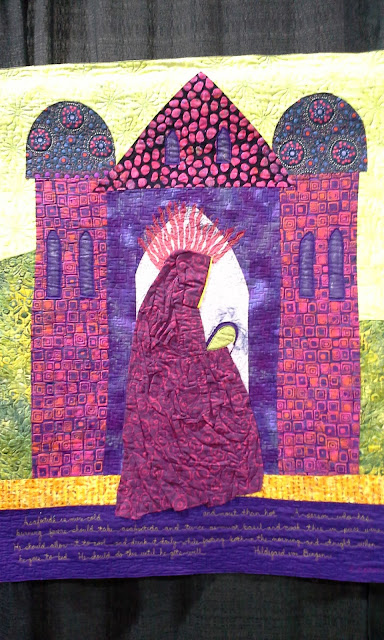Along
the Spice Route
Along
the Spice Route is an exhibit of 41 wall quilts interpreting a spice
used in cooking today and its country of origin. In addition to the
artistic interpretation of a spice, the goal of the exhibit is to
provide a learning opportunity to the origins of spices, learn the
importance of early trade routes and the connection between
countries. Curated by Ann Reardon and Paula Golden.
Below are my 12 favorites from the
Pennsylvania National Quilt Extravaganza XXII
Pennsylvania National Quilt Extravaganza XXII
September 2015 in Oaks, PA
The Color of Enlightenment-Saffron
by Ricki Smith Selva
"Saffron can be used as a dye as
well as a spice. This quilt depicts the saffron robes of a Theravada
Buddhist monk in Southeast Asia. The golden-orange color, which
represents wisdom, strength and dignity, traditionally came from
using saffron as a dye. A captivating photo taken by Katine Rogers in
2011 was the inspiration."
Road to Mathura- Ginger from India
by Carole A. Nicholas
"Ginger was first grown in
southern China. It was soon to be distributed through global trade
networks along the spice route to India. It can be used fresh or as a
ground powder. Ginger has a fiery taste with a hint of citrus. Here,
three women take their head loads of pungent, peppery ginger root to
market in Mathura. The ginger plant depicted in the filigree stone
screen ("jaali")."
Za'faran-Saffron by Ricki Smith Selva
"Saffron is the world's most
expensive spice. In Afghanistan saffron cultivation may offer a
legitimate alternative to opium production for some farmers. The
handwork is lovingly offered as homage to the painstaking work that
yields this gorgeous spice, and especially to the farmers of Kandahar
Province who are risking their livelihood to become part of saffron's
enduring story."
Hildegard's Herbal- Asafoetida by
Patricia Powers
"Asafoetida" is a spice from
northern India. It has a bitter taste that is softened by cooking it
in hot oil or butter. In this quilt Hildegard von Bingen, a nun
renown as a great healer. Hildegard was born in 1098. Her words on
Asafoetida in her manuscript "Physica" are shown here. Her
theories and those of oriental medicine have great similarities."
Banda Niera-Nutmeg by Karen Starnes
"Nutmeg was highly sought after
spice due to its medicinal properties, as well as hallucinogenic
effects when consumed in large quantities. "Banda Niera"
depicts mid 1500's Dutch traders negotiating a nutmeg purchase on the
shores of Banda Island. Their ship awaits in the bay between the
settlement of Banda Niera and the volcano named Fire Mountain."
The Spice Bazaar- Cumin by Karin Tauber
"Cumin seeds come from a plant
with lacy white/pink flowers, a member of the parsley family. Its
flavor is pungent, earthy with a sweet after taste. A spice bazaar is
depicted where cumin is found in many forms. There are dried bundles
on shelves, dried seeds in sacks, ground cumin in clay pots and a
bowl of black cumin in a corner. Inspired by a Silvia Hanna Dahdal
oil painting."
Mustard Seed- Western Asia by Susan Fox Price
"Mustard seeds come in three
varieties: black mustard, brown mustard, and white mustard. In the
time of the ancient Spice Route it was popular in China, India, and
the Middle East (Western Asia). This quilt focuses on the Middle East
where black mustard grows. We look from inside a stone house over an
ancient village with fields of mustard in the distance."
Turmeric by Alicia Cox MacWright
"Turmeric grows wild in the
forests of southern Asia. It has been used in southern India for
thousands of years as a dye, a medicine and a culinary spice. It was
used to dye the clothes of temple dancers known as "devadasis".
My quilt show these dancers performing the Bharata Natyam, a
classical Indian dance that originated in the temples of Tamil Nadu."
Tanzanian Cardamom by Peg Green
"Cardamom appears to have
originated in the Kerala hills of southern India. Cardamom trade came
overland into Asia Minor and by sea to the Arabian Peninsula and East
Africa. It is used in many spice mixtures and to flavor coffee in
some parts of the world. Here Cardamom flowers in stages from buds
through blooms and seedpods drift down across the surface of the
scene."
Cinnamon by Jill Jensen
"Cinnamon comes from Sri Lanka,
this type is what is known as "true" cinnamon. Its flavor
is sweet with a woody aftertaste. It is used in many dishes world
wide. I was drawn to cinnamon not by the flavor or scent but its rich
reddish-brown color. I have used block printing and fabrics that I
have discharged. The designs are reminiscent of Sri Lanka and the
leaves of the cinnamon tree."
"Saffron is carefully harvested
from the flower of the Crocus sativus, commonly known as the saffron
crocus. Saffron is the dried vivid crimson stigmas of the blossom.
Hundreds of flowers must be harvested to produce a commercially
useful amount; because of this it as remained "the gold" of
the spice trade."
Merci, Edmond Albious Vanillla,
Madagascar by Beth Wiesner
"Vanilla comes from Madagascar and
neighboring islands in the Southwestern Indian Ocean. It is derived
from orchids and is the second most expensive spice. Thanks to Edmond
Albious for discovering a hand pollinating method that saved the
vanilla orchid. A window, based on an historic arch in Ambohimanga,
Madagascar, frames the view of the vanilla crop."
********
This post is dedicated to my fellow blogger Tasha at The Purple Cook and to my other girlfriends, Barbara, Heather, Cindy and Greta, who have the gift of knowing how to use spices in their cooking.
This post is dedicated to my fellow blogger Tasha at The Purple Cook and to my other girlfriends, Barbara, Heather, Cindy and Greta, who have the gift of knowing how to use spices in their cooking.






























